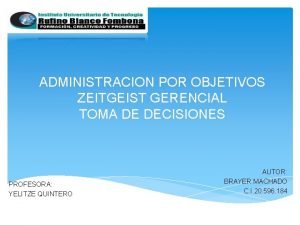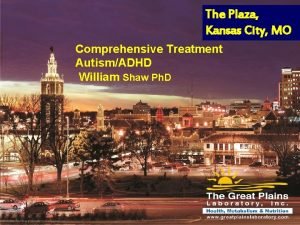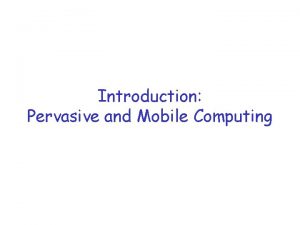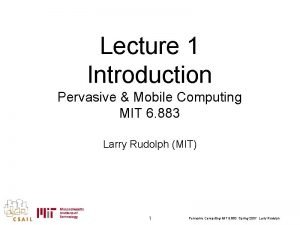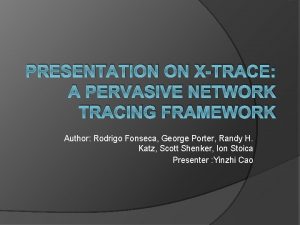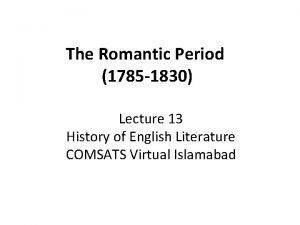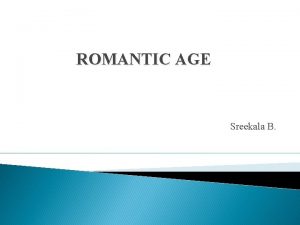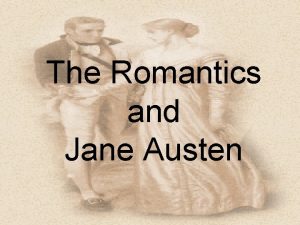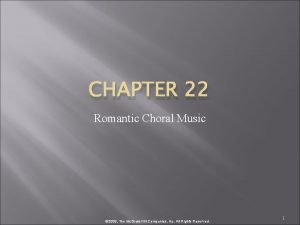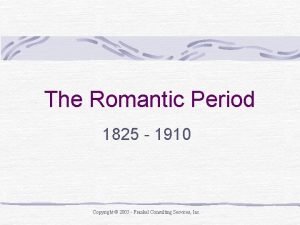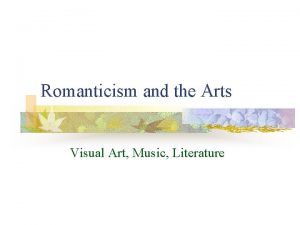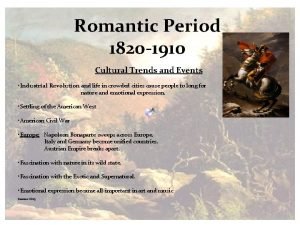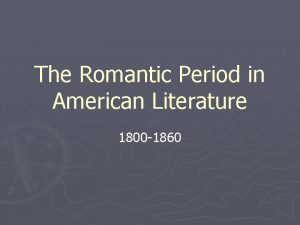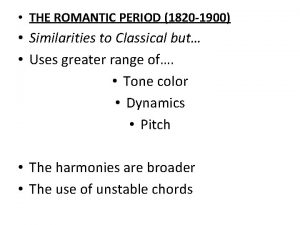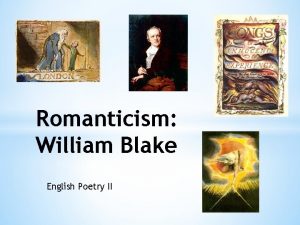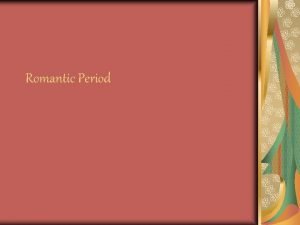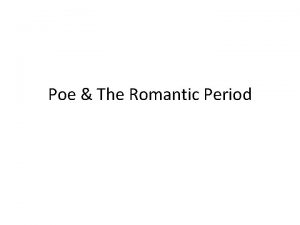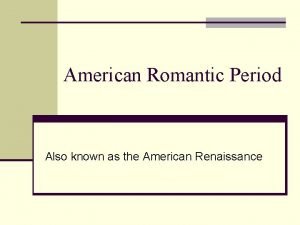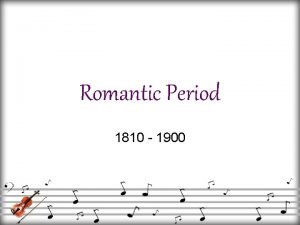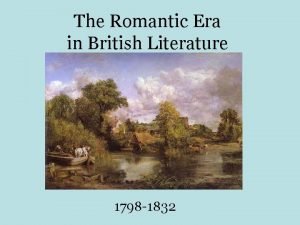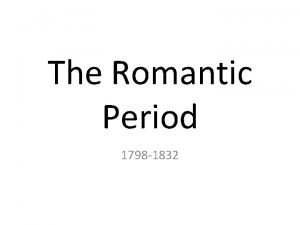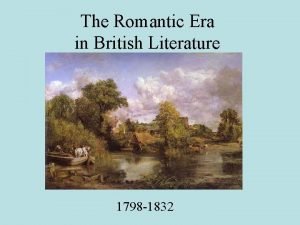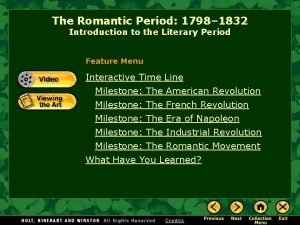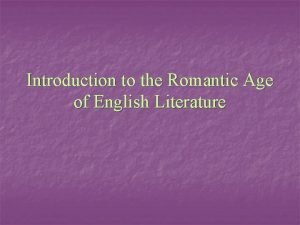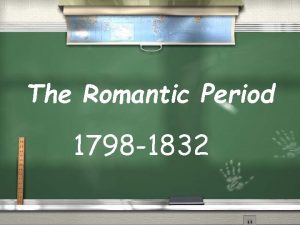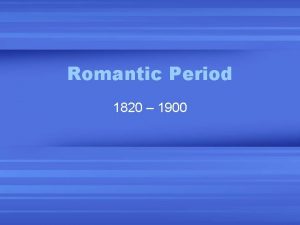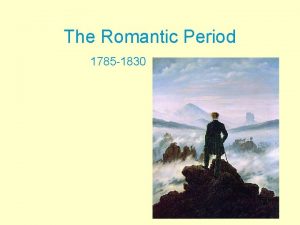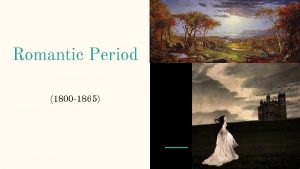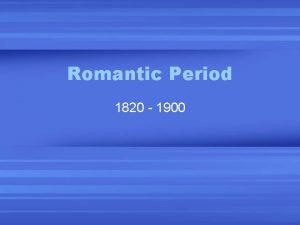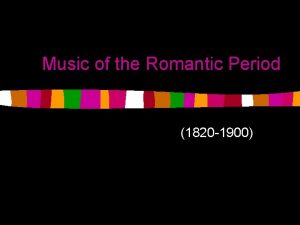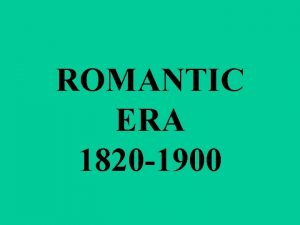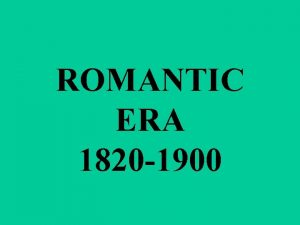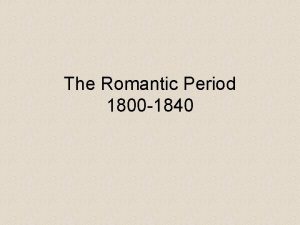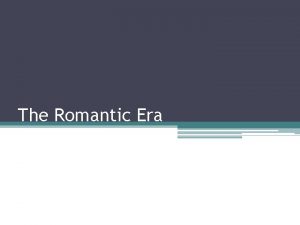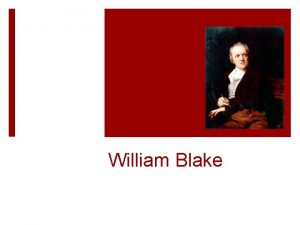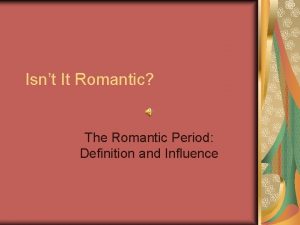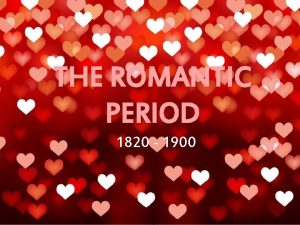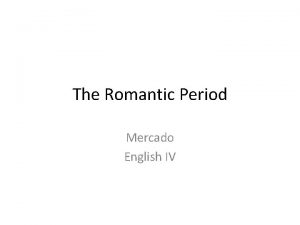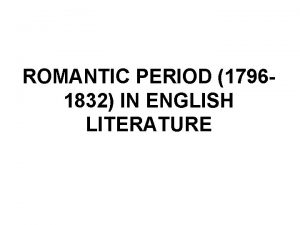The Romantic Period The Zeitgeist Zeitgeist a pervasive












































- Slides: 44

The Romantic Period The Zeitgeist

Zeitgeist: a pervasive intellectual climate. The Spirit of the Age In the Romantic Period we see an explosive release of artistic energy, an experimental boldness, and creative power that marks an artistic renaissance

• Keats had the sense that “great spirts now on Earth are sojourning. ” • In Shelley’s Defense of Poetry he claimed that the literature of his age “has arisen as it were from a new birth, ” and that “an electric life burns” within the words of the best writers, which is “less their spirit than the spirit of the age. ”

William Hazlitt, in The Spirit of the Age (1825) Described how the French Revolution seemed “the dawn of a new era, a new impulse had been given to men’s minds. ” And he said that the school of Wordsworth “had its origin in the French Revolution. ”

Characteristics of the Romantic Period • (1) Imagination, Emotions, and Intuition. Exaltation of intense feelings. • Descartes: I think, therefore I am. vs • Rousseau: I felt before I thought. • (2) Subjectivity of approach; the cult of the individual; the absolute uniqueness of every individual.

Characteristics of Romanticism (3) Freedom of thought and expression. • A revolt against authority and tyranny, against the ancien regime, whether social, political, religious, or artistic. • Thomas Paine: “The Rights of Man. ” • Mary Wolstonecraft: “A Vindication of the Rights of Woman” (1792) • Alienation and rebellion: Cult of Youth, Energy, and Idealism

Characteristics of Romanticism (4) Idealization of Nature • Embracing the uncivilized, the wild, the precivilized. • Rousseau: “Man is born free and everywhere he is in chains. ” In other words, civilization is in part the cause of our corruption. • The “noble savage, ” and James Fennimore Cooper’s Leatherstocking novels, I. e. The Last of the Mohicans.

But there were 2 views of Nature • The first viewed nature as peaceful, calm, nurturing, a source for spiritual renewal. It often showed an innocent life of rural dwellers, a world of peace and harmony which nurtures and comforts the human spirit. This is very much how Wordsworth viewed nature.

John Constable: The Hay Wain

But nature could also be frightening in its power, and cause a dizzying sense of awe and wonder.

J. M. W. Turner: Avalanche

Edmund Burke defined these two views of nature as: • The beautiful and • The sublime

A BRIEF SERIES OF PAINTINGS FROM THE ROMANTIC PERIOD Starting with Sir Joshua Reynolds, who was President of the Royal Academy in England



Blake quit the Royal Academy partly because of Sir Joshua Reynolds So, on to some of Blake works





Two Works by Henry Fuseli, a Swiss artist living in England who was friends with Blake



One of the most interesting artists of the period is J. M. W. Turner Starting with an early, fairly conventional painting











And then to end on John Constable Who said, “I try to paint as if I had never seen a painting before. ”




And then: Eugene Delacroix




And. . . Caspar David Friedrich

 Less complicated texture than baroque (more homophonic)
Less complicated texture than baroque (more homophonic) Modelo de zeitgeist
Modelo de zeitgeist Pddst
Pddst Pervasive developmental disorder
Pervasive developmental disorder Pervasive integration
Pervasive integration Pervasive and mobile computing
Pervasive and mobile computing Pervasive and mobile computing
Pervasive and mobile computing Specific and pervasive boundaries for behavior
Specific and pervasive boundaries for behavior Pervasive computing ppt
Pervasive computing ppt Melancholic features
Melancholic features Pervasive computing wikipedia
Pervasive computing wikipedia Mobile and pervasive computing
Mobile and pervasive computing X-trace: a pervasive network tracing framework
X-trace: a pervasive network tracing framework Romantic period poetry characteristics
Romantic period poetry characteristics 5 i's of romanticism
5 i's of romanticism Queen mab characteristics
Queen mab characteristics Jane austen and romanticism
Jane austen and romanticism Period of activism important key points
Period of activism important key points Romantic period choral music
Romantic period choral music Romanticism main characteristics
Romanticism main characteristics Characteristic of romantic period
Characteristic of romantic period Romantic period 1798 to 1832
Romantic period 1798 to 1832 Characteristic of romantic period
Characteristic of romantic period Romantic era american literature
Romantic era american literature Romantic time period
Romantic time period 1820 to 1910
1820 to 1910 The romantic period 1798 to 1832
The romantic period 1798 to 1832 Poetry character cavalier
Poetry character cavalier Romantic period american literature
Romantic period american literature Romanticism notes
Romanticism notes Vocal music of the romantic period
Vocal music of the romantic period Facts about romantic period
Facts about romantic period Romantic painting characteristics
Romantic painting characteristics Characteristic of romantic period
Characteristic of romantic period Romantic period dates
Romantic period dates American romantic period
American romantic period Characteristics of romantic period
Characteristics of romantic period Romantic period
Romantic period The romantic age (1798 to 1824)
The romantic age (1798 to 1824) Elements of romantic
Elements of romantic Romanticism poetry characteristics
Romanticism poetry characteristics Period
Period The era of change 1798-1832
The era of change 1798-1832 Romantic plays
Romantic plays History of english literature romantic age
History of english literature romantic age

